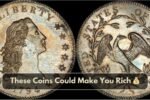If you’ve ever gone through an old coin jar or inherited a box of coins from a grandparent, you might be sitting on a small treasure without even knowing it. Some coins from the 1960s have skyrocketed in value, and collectors today are willing to pay big bucks for the right pieces. Wondering if you might have one of these valuable coins? Let’s dive in and explore five coins from the 1960s that are worth way more than their face value.
Why Are Old Coins So Valuable?
Before we get into the specific coins, you might ask—why are these old coins even valuable?
Well, a few things make a coin valuable:
- Rarity – Fewer coins made or remaining today.
- Condition – Coins with little to no damage (called “mint condition”) are worth more.
- Errors – Mistakes during production can make coins more unique and sought after.
- Historical significance – Coins from special years or events can attract collectors.
Alright, now let’s check out those hidden gems from the 1960s!
1964 Kennedy Half Dollar (90% Silver)
This one’s a classic. The 1964 Kennedy Half Dollar was the first to honor President John F. Kennedy after his assassination in 1963. It’s also the last half dollar made with 90% silver, which makes it very attractive to both collectors and silver investors.
Even though millions were made, the value depends on its condition. A high-grade one can be worth $50 or more, and special proof versions are even pricier.
Quick Tip: If it has a shiny mirror-like finish, you may have a proof coin – those are super collectible!
1969-S Lincoln Cent (Double Die Obverse)
Here’s one you definitely want to watch for. The 1969-S penny has a double die error, which means the text on the front (like “LIBERTY” and the date) looks doubled. This mistake is rare, and collectors go wild for it.
Some have sold for over $35,000!
Heads-up: Only the ones with the “S” mint mark (from San Francisco) and clear doubling are valuable.
1965 Roosevelt Dime (Silver Error)
Normally, starting in 1965, dimes were made from a copper-nickel blend instead of silver. But a few 1965 Roosevelt dimes were accidentally struck using the old silver planchets (coin blanks).
If you find a 1965 dime with a silver look and no copper edge, don’t spend it! These rare errors have sold for hundreds to even thousands of dollars depending on condition.
| Feature | Regular Dime | Silver Error Dime |
| Weight | ~2.27g | ~2.5g |
| Edge | Copper stripe | No copper stripe |
1960 Small Date Lincoln Cent
This one’s a bit more subtle, but collectors love varieties like the 1960 Small Date penny. There are two types: Small Date and Large Date. The small date version is harder to find, especially in good condition.
It’s not worth thousands, but it can sell for $20 to $100 or more, especially if it’s in mint state. Not bad for a penny, right?
How to Spot It: On the small date version, the “0” in the date is higher and smaller compared to the large date one. It takes a sharp eye or a magnifying glass.
1968 No-S Roosevelt Dime (Proof Error)
Now this one is extremely rare. In 1968, proof coins (which are super shiny and made specially for collectors) were supposed to be minted in San Francisco and marked with an “S”.
But a few 1968 proof dimes were made without the S mint mark. Only a handful are known to exist. If you’ve got one, you’re looking at $10,000 or more.
Just remember: This only applies to proof coins, not the regular ones used in everyday transactions.
Conclusion
So, next time you’re cleaning out a drawer or checking your change, take a closer look. You never know—you could be holding onto a coin worth more than you imagined. Coins from the 1960s may seem ordinary, but some are hidden treasures. With a little knowledge and a bit of luck, your pocket change might just turn into a payday.
FAQs
What makes a coin from the 1960s valuable?
Mainly its rarity, condition, and whether it has any minting errors or silver content.
Where can I check the value of my old coins?
You can look online at coin collector sites, visit a coin shop, or use coin value apps.
Do I need special tools to check my coins?
A magnifying glass and a digital scale can help spot small details and errors.
Should I clean my old coins before selling them?
No! Cleaning can lower the value. Collectors prefer coins in their original condition.
Are all 1960s coins valuable?
Not all, but some specific years and types are. Always check the details!





